The taiga doesn't have as many plant and animal species as the tropical or the deciduous forest biomes. It does have millions of insects in the summertime. Birds migrate there every year to nest and feed.
Here is some information about the temperatures and weather in the taiga. The average temperature is below freezing for six months out of the year. The winter temperature range is -54 to -1° C (-65 to 30° F). The winters, as you can see, are really cold, with lots of snow.
Temperature range in the summer gets as low as -7° C (20° F). The high in summer can be 21° C (70° F). The summers are mostly warm, rainy and humid. They are also very short with about 50 to 100 frost free days. The total precipitation in a year is 30 - 85 cm (12 - 33 in) . The forms the precipitation comes in are rain, snow and dew. Most of the precipitation in the taiga falls as rain in the summer.
The main seasons in the taiga are winter and summer. The spring and autumn are so short, you hardly know they exist. It is either hot and humid or very cold in the taiga.
There are not a lot of species of plants in the taiga because of the harsh conditions. Not many plants can survive the extreme cold of the taiga winter. There are some lichens and mosses, but most plants are coniferous trees like pine, white spruce, hemlock and douglas fir.
Coniferous trees are also known as evergreens. They have long, thin waxy needles. The wax gives them some protection from freezing temperatures and from drying out. Evergreens don't loose their leaves in the winter like deciduous trees. They keep their needles all year long. This is so they can start photosynthesis as soon as the weather gets warm. The dark color of evergreen needles allows them to absorb heat from the sun and also helps them start photosynthesis early.
Evergreens in the taiga tend to be thin and grow close together. This gives them protection from the cold and wind. Evergreens also are usually shaped like an upside down cone to protects the branches from breaking under the weight of all that snow. The snow slides right off the slanted branches.
The taiga is susceptible to many wildfires. Trees have adapted by growing thick bark. The fires will burn away the upper canopy of the trees and let sunlight reach the ground. New plants will grow and provide food for animals that once could not live there because there were only evergreen trees.
Animals of the taiga tend to be predators like the lynx and members of the weasel family like wolverines, bobcat, minks and ermine. They hunt herbivores like snowshoe rabbits, red squirrels and voles. Red deer, elk, and moose can be found in regions of the taiga where more deciduous trees grow.
Many insect eating birds come to the taiga to breed. They leave when the breeding season is over. Seed eaters like finches and sparrows, and omnivorous birds like crows stay all year long.
TAIGA PLANTS
- Balsar Fir
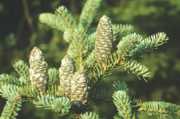 - Black Spruce
- Black Spruce 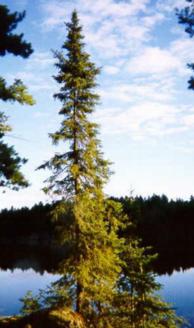
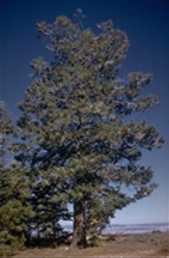 - Eastern Red Cedar
- Eastern Red Cedar 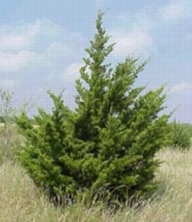 - Jack Pine
- Jack Pine 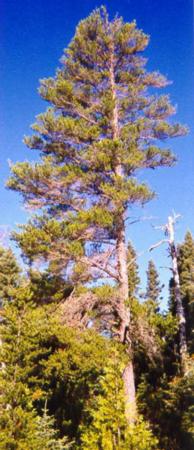
- American Black Bear
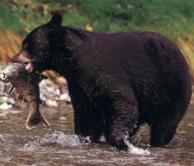
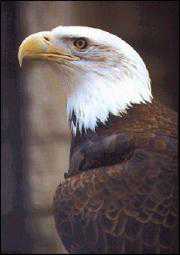
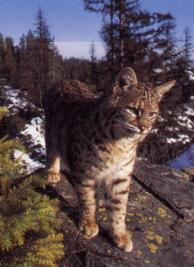
Taiga is in Köppen's Dfc climate category. The Dis a snow climate, while the fmeans there is enough precipitation in all months. The cmeans that fewer than 4 months have an average temperature over 50° F (10° C).
The taiga climate is for the most part dominated by cold arctic air. Exceptionally cold winds bring bitterly cold air from the Arctic Circle: the temperatures fall even more on clear nights when there is no cloud cover. Because of earth's tilt, the taiga is turned away from the sun in the winter. Less of the sun's radiation reaches the ground to warm it up.
Winter, with it's freezing cold temperatures, lasts for six to seven months. Summer is a rainy, hot and short season in the taiga. Fall is the shortest season for taiga. Spring brings flowers, the frozen ponds melt, and the animals come out from hibernation.
The lowest and highest temperatures that occur for taiga are the following:
Winter's LOWEST temperature in taiga is -65°F.The temperature range, as you can see, is -65° F to 70°F (-54 to 21° C). For half of the year, the average temperature is below freezing. In the winter the average air temperature is warmer than it is for tundra, which lies north of the taiga.
Winter's HIGHEST temperature is 30° F.
Summer's LOWEST temperature is 30° F.
Summer's HIGHEST temperature is 70° F.
The taiga climate has an average annual rainfall of 12 - 33 inches (30 - 84 cm). Most of it falls in the summer as rain.
The corresponding biome would be the Taiga biome. The global range for taiga goes all around the world from Alaska, to Canada, Scandinavia, Russia and China. Taiga climate is only found in the northern hemisphere, because there isn't enough land mass in the southern hemisphere to create a taiga climate there.
The taiga is a moist subarctic forest that begins where the Tundra ends. The winters are long, dark and cold with lots of snow, and the summers are warm and short when the daylight can be up to 20 hours long. The average climate for the taiga each year falls below -32°F (0°C). The
taiga can be as low as -76°F (60°C). In the summer the temperature can reach as high as 104°F (40°C). The major type of vegetation in the taiga biome are coniferous evergreens. Needles on evergreen trees of the taiga are thin, wax-covered and they do not fall off in the fall. The conifers of the taiga keep their leaves all year around. Needles are the leaves in the taiga biome. Conifers are adapted to the taiga environment because they lose less water and shed snow more easily because of their conical shape. Some types of adaptations in the animals are migration, heavier coats of fur, and some change color, such as the snow-shoe rabbit. Mice and moles live in tunnels under the snow. Some animals that live in the taiga are bears, badger, beavers, reindeer, foxes, wolverine and squirrels. Many birds migrate to the taiga during the spring because there are so many insects to feed on after the snow melts. The latitude range is approximately between 50°-60° North latitude.
The taiga climate under Köppen's classification system are Dfb and Dfc. The letters of the climate codes mean the following; D = snow climates, f = sufficient precipitation in all months, b = warmest month average under71.6°F (22°C) at least 4 months have an average of over 50°F (10°C), and c = Fewer than 4 months with average temperatures over 50°F (10°C).
The average temperature per year is 32°F (0°C) The average temperature for the summer can be over 50°F (10°C). The average winter temperature is under 26.6°F (-3°C). The highest temperature for the taiga biome has been 104°F (-60°C). I guess it would be an uncomfortable place for humans to live in. However, millions of people live there.
The average precipitation per year is about 40 inches. The average precipitation for the summer is between 10-20 inches. The average precipitation for the winter is between 20-40 inches. The type of precipitation that falls in the taiga climate are rain in summer and
mostly snow in winter.
Something I find interesting about the climate of this biome is that the temperature can change from one extreme to another. I didn't think that a place farther north from us could have higher temperatures then we do.
No comments:
Post a Comment